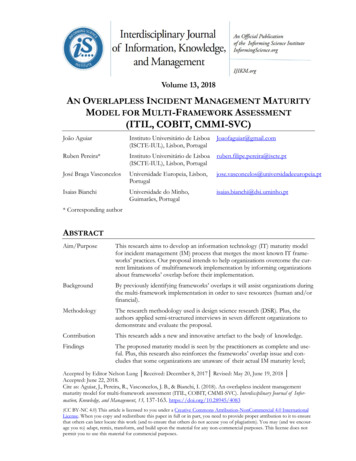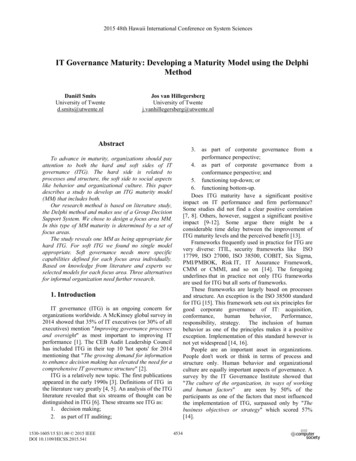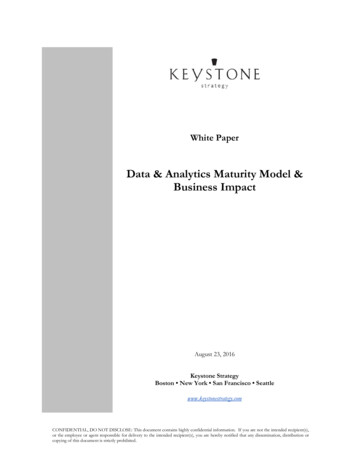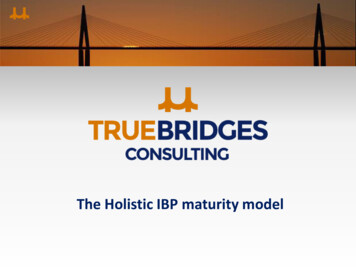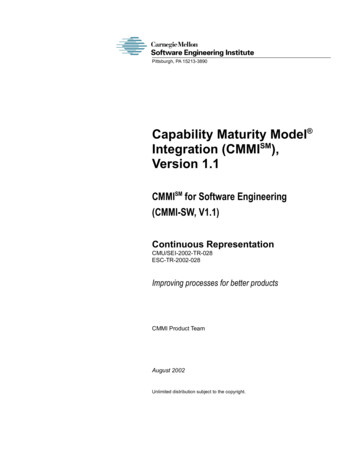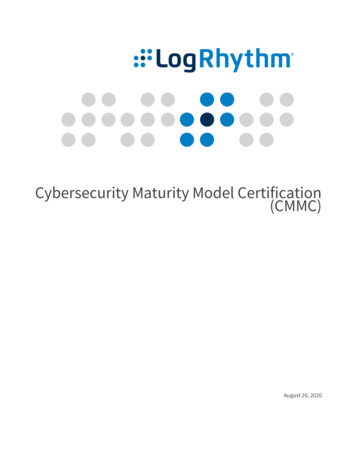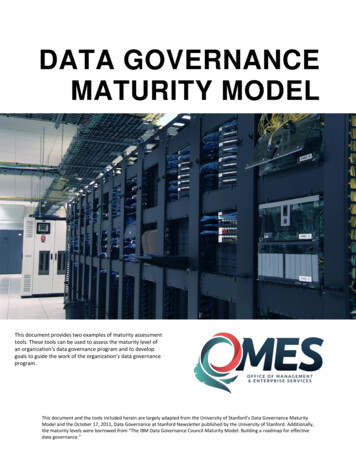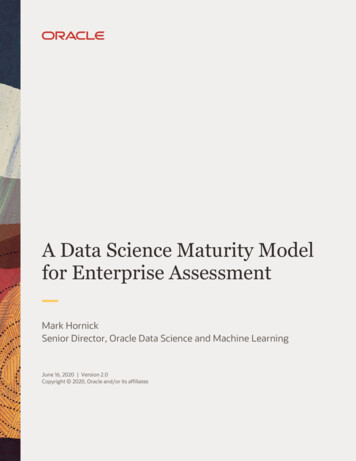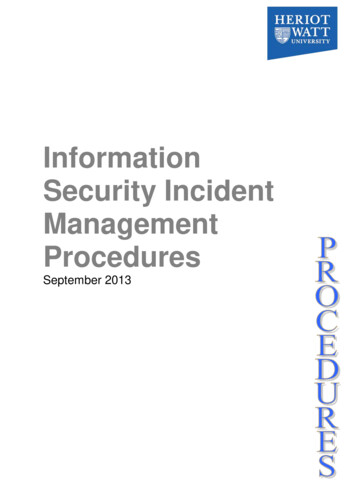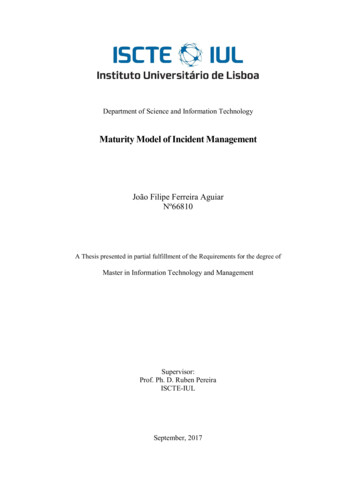
Transcription
Department of Science and Information TechnologyMaturity Model of Incident ManagementJoão Filipe Ferreira AguiarNº66810A Thesis presented in partial fulfillment of the Requirements for the degree ofMaster in Information Technology and ManagementSupervisor:Prof. Ph. D. Ruben PereiraISCTE-IULSeptember, 2017
Maturity Model of Incident ManagementDepartment of Science and Information TechnologyMaturity Model of Incident ManagementJoão Filipe Ferreira AguiarNº66810A Thesis presented in partial fulfillment of the Requirements for the degree ofMaster in Information Technology and ManagementSupervisor:Prof. Ph. D. Ruben PereiraISCTE-IULSeptember, 2017i
Maturity Model of Incident Managementii
Maturity Model of Incident ManagementAcknowledgementsSince September of 2016 when I start this thesis, I had the pleasure of learn andcollaborate with several people. All of them helped me to develop my skills.First, I would like to thank to my supervisor, Professor Rúben Pereira, for all the effortand availability dedicated to this thesis. The weekly situation points gave me workingguidelines which was very useful. Thank you once again, for all the time you spent withme.Thanks to all the people of organizations that collaborated with this thesis. The pricelesstime spent to evaluate their process was very useful to this investigation.I would also like to thank to my closest family. To my parents, my sisters, my brothersin-law, nephews and parents-in-law for all the help they gave me and for the momentsthat I gave up of their company to work on this thesis.Last but not least, I would like to thank to my fiancée, Ondina Aguiar, who supported meall the time. Without her loving support and help I would have never been able toaccomplish this thesis.iii
Maturity Model of Incident Managementiv
Maturity Model of Incident ManagementTítulo: Modelo de Maturidade para a Gestão de IncidênciasNome: João Filipe Ferreira AguiarMestrado em: Informática e GestãoOrientador: Doutor Rúben Filipe de Sousa PereiraResumoNos últimos 25 anos a preocupação da generalidade das empresas com as Tecnologias daInformação (TI) é claramente exponencial. De tal forma que, para conseguirem organizar,planear, selecionar, suportar e entregar os serviços de TI, foi necessário implementarframeworks de TI. Estas frameworks são um conjunto de boas práticas a implementarpara gestão de serviços de TI.Nestas frameworks estão incluídos vários processos das diferentes áreas das TI. Estetrabalho de investigação focou-se muito concretamente no processo de Gestão deIncidências. Sendo que a operacionalidade da generalidade dos serviços requererdisponibilidade de quase 24/7, a implementação deste processo é fulcral.Muitas das frameworks de TI contem processos similares. Muitas organizações, quandotentam aplicar mais que uma framework acabam por fazer trabalho redundante. Assimsendo, a eliminação de sobreposições das atividades torna-se bastante útil para qualquerprocesso das frameworks de IT. Desta forma o processo torna-se mais simples e menosdispendioso para a organização.Dada a necessidade das organizações de avaliarem a maturidade do seu processo degestão de incidências e que diferentes organizações têm diferentes frameworks de TI,nasceu a necessidade deste trabalho de investigação.Esta tese propõe um Modelo de Maturidade para o processo de gestão de incidências queabranja as principais e mais utilizadas frameworks de TI.Palavras-Chave: Gestão de Incidências, Modelo de Maturidade, Frameworks de TI,Sobreposição de Frameworks.v
Maturity Model of Incident ManagementTitle: Maturity Model of Incident ManagementName: João Filipe Ferreira AguiarMaster: IT and ManagementSupervisor: Doctor Rúben Filipe de Sousa PereiraAbstractOver the last 25 years the concern of most organizations with Information Technology(IT) has been clearly exponential. In order to plan, organize, select, support and deliverIT services, it was necessary to implement IT frameworks. These frameworks are a set ofthe best practices to implement on IT service management.These frameworks are included in several processes of different areas of IT. This researchwork is focused very concretely on the Incident Management process. Once theorganizations technical consulting services are available 24/7, an implementation of thisprocess is crucial.Many of the IT frameworks contain similar processes. Many organizations, when tryingto apply more than one framework, end up doing redundant work. Therefore, eliminatingoverlaps of activities becomes very useful for any process of IT frameworks. In this way,the process becomes simpler and less expensive for the organization.Given the need of the organizations evaluate the maturity of their incident managementprocess and different organizations and different IT frameworks, was born the need forthis research.This thesis proposes a Maturity Model for the incident management process that coversthe main and most used IT frameworks.Keywords: Incident Management, Maturity Model, IT Framework, OverlappingFrameworks.vi
Maturity Model of Incident ManagementTable of ContentsAcknowledgements . iiiResumo . vAbstract . viTable of Contents . viiList of Tables . ixList of Figures . xChapter 1 – Introduction . 11Chapter 2 – State of the Art. 152.1. IT Frameworks . 162.1.1. ITIL. 172.1.2. COBIT . 232.1.3. CMMI . 262.1.4. Frameworks conclusions and summary. 292.2. Maturity Model Frameworks . 302.2.1. COBIT PAM . 322.2.2. ISO/IEC 15504 . 342.2.3. CMMI-SVC . 362.2.4. TIPA . 392.2.5. AXELOS . 412.2.6. J. Flores, L. Rusu and P. Johannesson Model . 432.2.7. R. Pereira, and M. Silva Model . 462.2.8. M. Vitoriano and J. Neto Model . 492.2.9. M. Simonsson, P. Johnson and H. Hijkstrom Model . 512.2.10. Comparison Maturity Models Frameworks. 53Chapter 3 – Research Methodology . 553.1. Data collection . 563.2. Data analysis . 57Chapter 4 – Proposal . 59Chapter 5 - Analysis and discussion of results . 65Chapter 6 – Conclusions . 73Bibliography . 75Appendix . 78Appendix A . 78Appendix B . 89Appendix C . 101vii
Maturity Model of Incident ManagementAppendix D . 110Appendix E . 120Appendix F . 126viii
Maturity Model of Incident ManagementList of TablesTable 1- Processes – ITIL. 19Table 2- IM Roles – ITIL . 21Table 3- DSS Domain – COBIT 5 . 24Table 4- Activities from COBIT 5 . 25Table 5 -Process Areas from CMMI SVC. 27Table 6- Relationship between IRP Process - CMMI . 27Table 7- Specific Goal and Practices – CMMI. 28Table 8- Activities – CMMI . 28Table 9- Comparison IT Frameworks . 29Table 10- Capability Levels – COBIT PAM . 33Table 11- Capability Levels- ISO/IEC 15504 . 35Table 12- Capability Levels – CMMI-SVC . 36Table 13- Maturity Levels – CMMI . 37Table 14 -Maturity Levels – TIPA . 39Table 15- Maturity Levels- Axelos . 42Table 16- Proposed Activities . 43Table 17- Service Capacity and Service Continuity. 44Table 18- Stage Model and Continuous Model . 47Table 19- Type of Questions and Answers . 47Table 20- Fulfill of Requirements . 51Table 21- Comparison Maturity Models Frameworks . 53Table 22- Comparison of Maturity Models Levels . 53Table 23- Interviewees Profile . 56Table 24- Excerpt of CMMI activities . 59Table 25- Excerpt of activities merged . 60Table 26- Excerpt of applied questionnaire. 61Table 27- Questionnaire header . 62Table 28- Questionnaire header 2 . 63Table 29- Organizations Comparison . 65Table 30- Activities completed by all organizations . 69Table 31 - Interviewees’ opinion about IM process maturity model . 72ix
Maturity Model of Incident ManagementList of FiguresFigure 1- Service Life Cycle - ITIL . 18Figure 2- Incident Management Process - ITIL . 20Figure 3- COBIT Principles . 23Figure 4- Areas from COBIT 5 . 24Figure 5- Process DSS02 – Manage Service Requests and Incidents- COBIT 5 . 25Figure 6- Process Assessment Mo
Capability Maturity Model Integration (CMMI) is another widely used IT framework. This model, focuses on the activities that are associated with the service provided by the organization, to provide quality of service to customers and final consumers [6]. CMMI provides to organizations a means to achieve service improvement [7].
